Understanding RF Cables: The Ultimate Guide
July 30,2025
Introduction:
RF cables (Radio Frequency cables) might seem technical, but we encounter them often in daily life. From connecting your TV to an antenna to linking radio transmitters, these cables carry high-frequency signals reliably. In this comprehensive guide, we’ll break down what RF cables are, the different types available, how they’re used (especially in TVs and electronics), and answer common questions. By the end, you’ll know the key differences between RF cables and other cables (like coaxial, RCA, SDI), how to choose the best RF cable for your needs, and even a bit about making or extending your own cables. Each section is kept concise (with short paragraphs) for easy reading and quick understanding.
What Is an RF Cable?
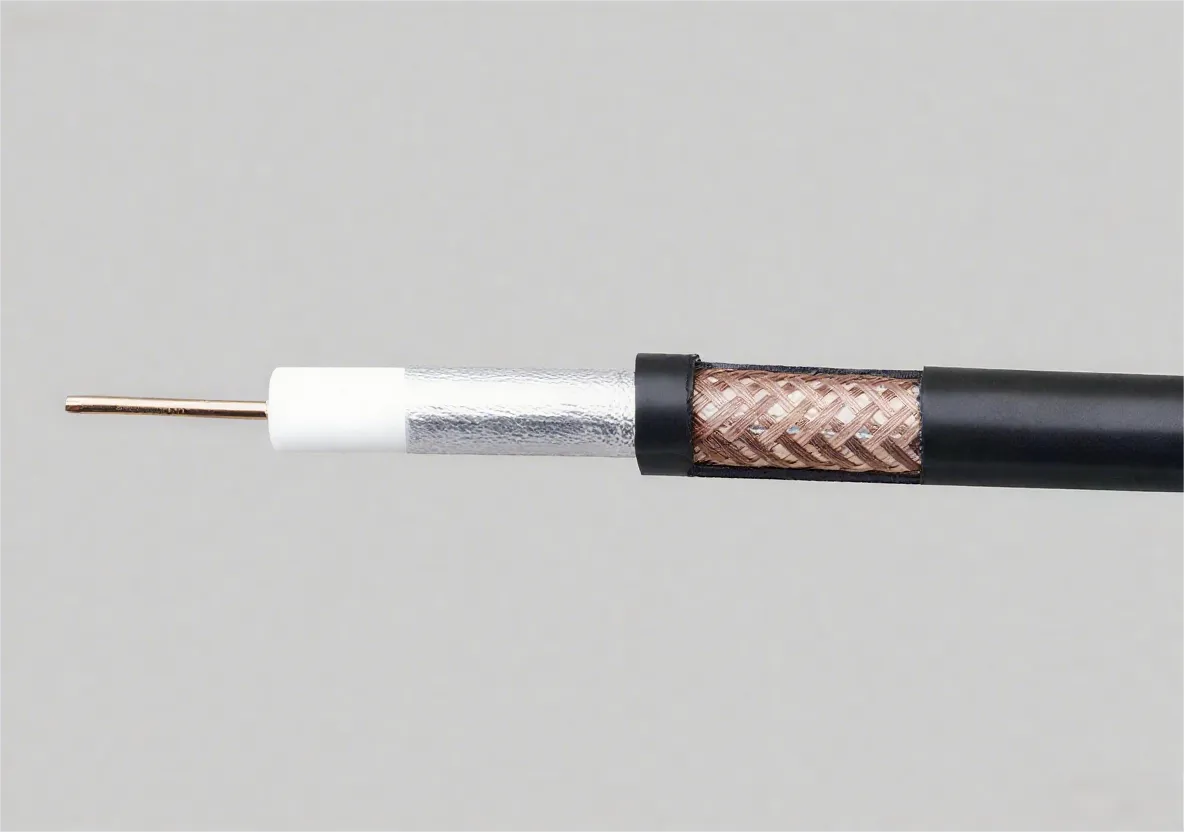
“RF” stands for Radio Frequency. An RF cable is essentially a cable designed to carry radio frequency signals from one device to another. In practice, most RF cables are coaxial cables – meaning they have a specific layered design that keeps the signal protected. Coaxial RF cables have a central conductor wire, an insulating dielectric layer, a shielding (braided metal foil) around that, and an outer jacket. This design minimizes signal loss and interference, which is why coaxial cables are ideal for RF transmission . In other words, an RF cable and a coaxial cable are often the same thing, especially when people talk about hooking up TVs or antennas.
What cable is used for RF signals?
Almost always, a coaxial cable is used to carry RF signals. The coaxial construction allows radio frequency currents to travel efficiently without radiating away or picking up noise. For example, the cable from your cable TV wall outlet to your TV or modem is a coaxial RF cable. Likewise, the wires connecting a radio transmitter to its antenna are coax cables. Different RF applications (TV, radio, Wi-Fi, etc.) might use slightly different coax cable types, but the concept is the same: a round, shielded cable carrying high-frequency electrical signals.
RF cables transmit high-frequency signals (often in the MHz to GHz range) with minimal loss, making them indispensable for broadcasting, telecommunications, and more . Whenever you need to send a signal that oscillates very quickly (radio waves), an RF coaxial cable is likely the tool for the job.
RF Cable vs. Coaxial Cable: Is There a Difference?
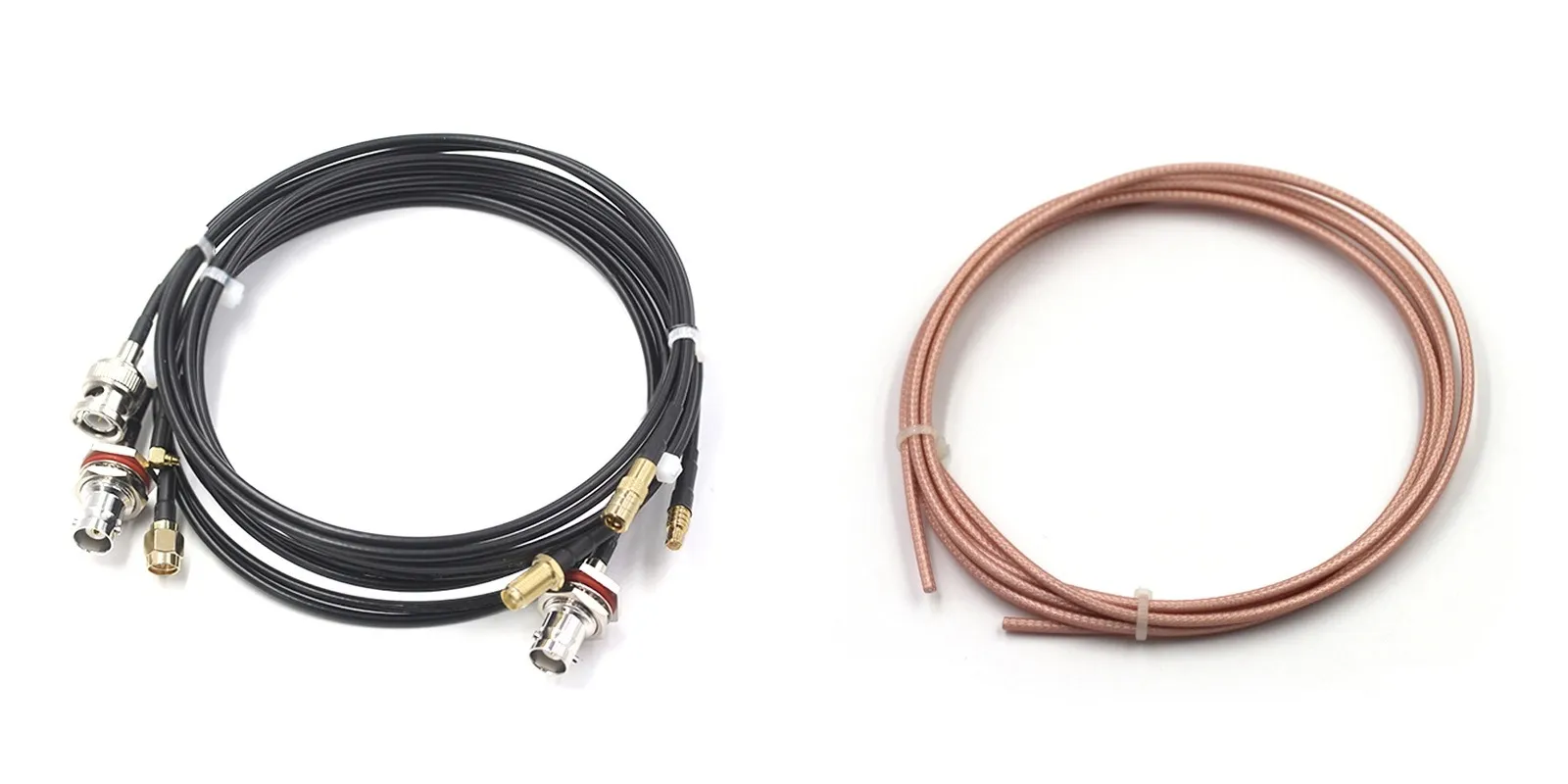
You might be wondering about the term “RF cable” vs “coaxial cable.” In most contexts, these terms overlap heavily. A coaxial cable (or “coax”) is a type of cable with that concentric layered design we described. It’s used as a transmission line for radio frequency signals . So, when someone says “RF cable,” they’re usually referring to a coaxial cable meant for RF transmission.
The difference, if any, is mostly semantic. “RF cable” emphasizes the purpose (carrying RF signals), whereas “coaxial cable” emphasizes the construction (coaxial design). Practically speaking, if you ask for an RF cable in a store, you’ll likely be handed a coaxial cable with the appropriate connector (like an F-type plug for TV). There’s no separate mysterious “RF-only” cable; coaxial cables are the standard RF cables.
In summary: RF cable = Coaxial cable (for RF applications). There’s no contrast like one being more expensive or anything – they’re just two ways to describe the same thing in many cases. So the difference between an RF cable and a coaxial cable is essentially none – an RF cable will almost always be a coaxial cable designed for high-frequency signals.
Common Types of RF Coaxial Cables
Not all RF coaxial cables are identical. There are various types of RF cables, each optimized for different uses. Here are some of the common ones:
- RG6 Coaxial RF Cable: A 75 Ω (ohm) cable widely used for cable television, satellite TV, and antenna hookups. RG6 has relatively low signal loss at high frequencies, making it great for TV signals and broadband internet. In modern homes, the cable from the wall to the TV or cable box is likely RG6. It’s thicker than some other types, with high-quality shielding.
- RG59 Coaxial RF Cable: Another 75 Ω cable that was common in older analog TV setups. It’s thinner than RG6 and has higher attenuation (signal loss) at higher frequencies. Today RG59 is mostly used for lower-frequency applications like some CCTV camera systems or short cable runs. For high-frequency needs (e.g., digital TV), RG59 is less ideal due to more signal loss.
- RG58 Coaxial RF Cable: A 50 Ω cable often used in networking (think older Ethernet coax networks) and amateur radio. It’s a common RF cable for lower-power transmitters or lab use. RG58 is thinner and more flexible, but it has more loss than some thicker 50 Ω cables.
- LMR-400 and other Low-Loss Cables: This is a family of modern 50 Ω coax cables designed for very low attenuation. For example, LMR-400 coax is popular for ham radio, cellular boosters, and Wi-Fi antennas, because it preserves signal strength over long runs much better than RG58. These cables are thicker and sometimes called “low loss RF cables.” They’re a bit more expensive but great when signal loss must be minimized.
- 75 Ohm vs 50 Ohm: You’ll notice some cables are rated 75 Ω (like RG6/RG59) and others 50 Ω (like RG58/LMR). This refers to the cable’s characteristic impedance. 75 ohm RF cables are standard for video and TV systems (they carry broadcast TV signals optimally), whereas 50 ohm RF cables are standard for radio transmitters, receivers, and data (Wi-Fi, radio communication). It’s important to use the right impedance for your equipment to avoid signal reflections. For example, TV antenna inputs expect 75 Ω coax; most radio transmitters expect 50 Ω coax.
- Flat RF Cable: Most coax is round, but there are flat RF cables designed to run under carpets or through window seals without much bulge. These are essentially flat-profile coaxial cables. They sacrifice some thickness (and thus a bit more loss) for the convenience of a low-profile shape. If you need to pass an RF cable through a closed window or a tight door gap, a flat coax adapter can help.
Each cable type has its specifications such as attenuation (loss per length at given frequency), power handling, and flexibility. For instance, RG6 typically has about 6–7 dB signal loss per 100 feet at 1 GHz, whereas a low-loss cable like LMR-400 might only lose ~3–4 dB over the same length and frequency. Always choose a cable type appropriate for the frequencies and distances in your setup.
RF Cable Connectors and Adapters
An RF cable isn’t very useful without connectors on the ends. There are many kinds of RF cable connectors, each suited to different applications and frequencies. Some common RF connectors include:
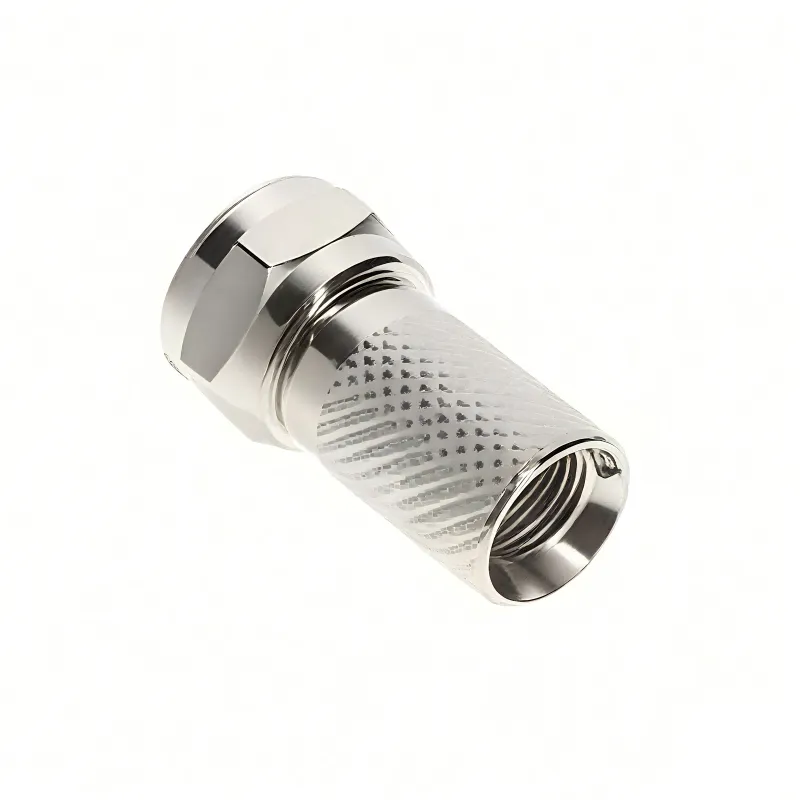
The F-type connector is a 75Ω threaded coaxial RF connector commonly found in TV antenna and cable systems. It offers reliable signal transmission with minimal loss, ideal for home entertainment setups.
F-type Connector: This is the familiar screw-on connector found on cable TV cords. It’s a 75 Ω connector often used for TV antennas, cable boxes, and modems. If you look behind your TV and see a threaded coax jack labeled “ANT/Cable In,” that’s for an F-type RF coax connector (often just called the antenna cable).
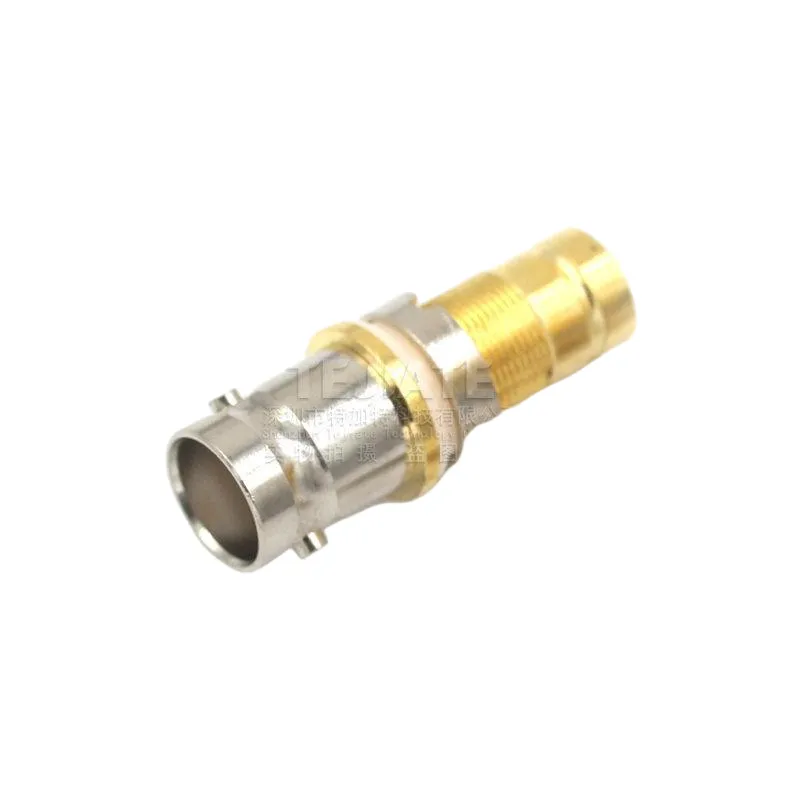
BNC connectors offer a quick-connect bayonet-style lock, ideal for professional AV systems, SDI broadcast video, and RF instruments. Available in both 50Ω and 75Ω variants, they provide versatility and secure connections.
- BNC Connector: A quick bayonet-style connector (you push in and twist to lock). BNC connectors are common in professional video (SDI cables), test equipment, and radio gear. They come in 50 Ω and 75 Ω versions. For example, many oscilloscopes and radio receivers use BNC RF connectors for input.
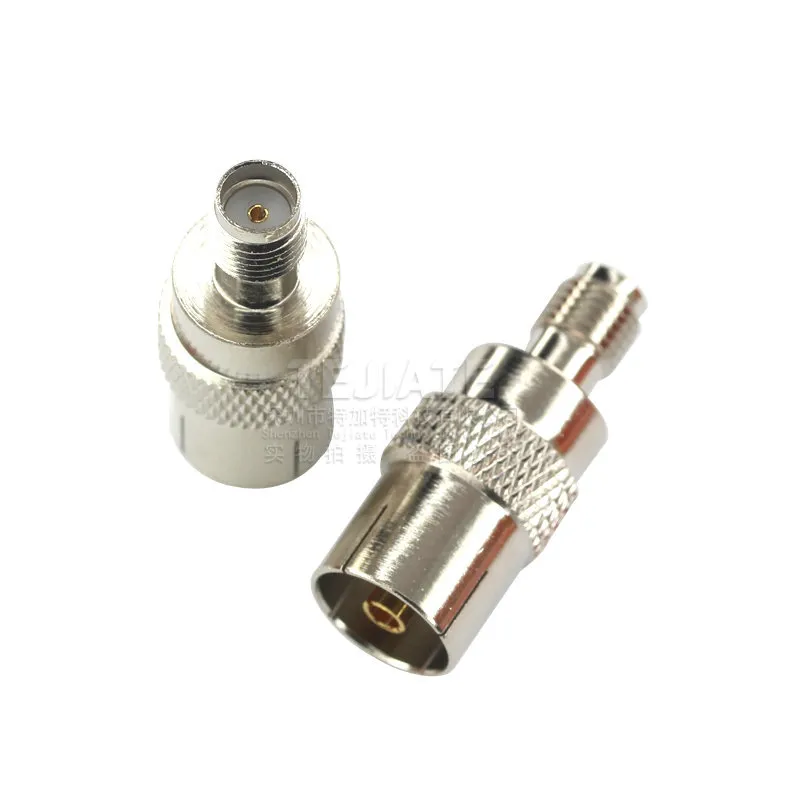
SMA connectors are compact screw-on RF connectors rated for high frequencies, commonly used in Wi-Fi routers, GPS devices, and microwave communications. Their threaded design ensures stable signal performance in compact systems.
- SMA Connector: A small screw-on connector used for higher frequency RF (like Wi-Fi antennas, cellular antennas, and microwave frequency equipment). SMA RF cables are common on things like router antennas or GPS antennas. There are also reverse-polarity SMA (RP-SMA) used in Wi-Fi equipment.
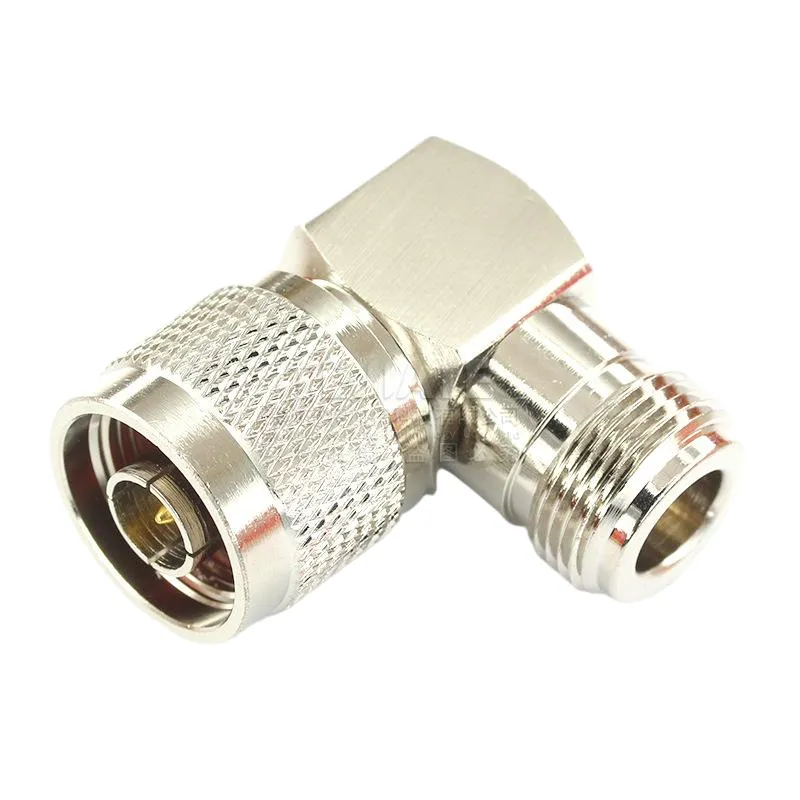
N connectors feature a robust screw-type design suited for high-frequency, high-power, and outdoor RF applications. Their weatherproof construction makes them ideal for antennas, base stations, and rugged environments.
- N Connector: A larger threaded connector rated for weatherproof connections and higher power. Often seen on outdoor antennas, satellite dishes, and some radio transmitters. An N-type connector is sturdy and maintains a good 50 Ω impedance up into microwave frequencies.
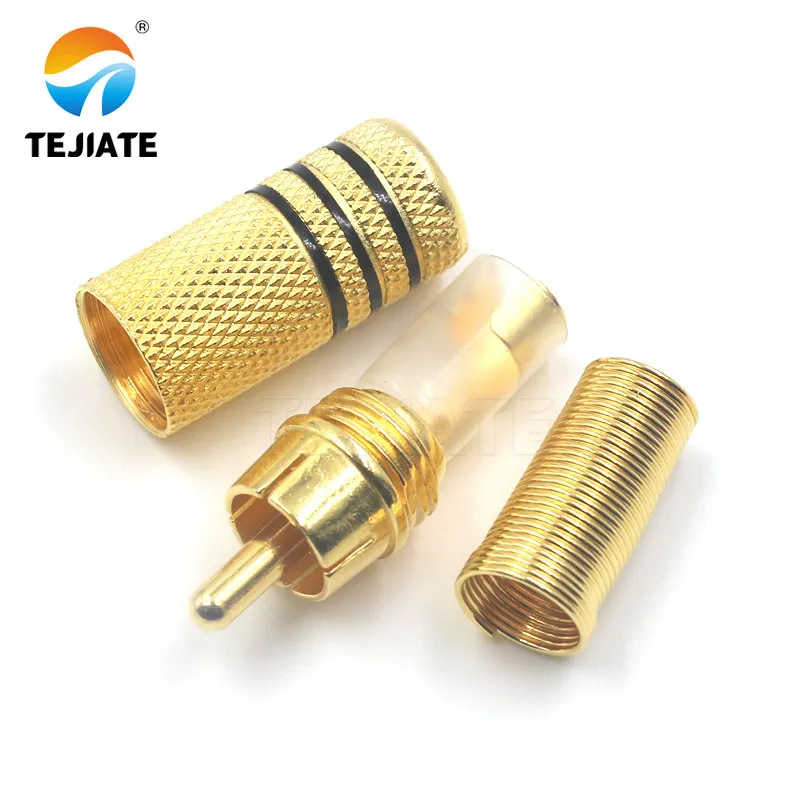
RCA connectors are analog AV plugs used to transmit composite video and stereo audio. Though not RF connectors, they are often used in home theater setups and vintage electronics for direct signal transmission.
- RCA Connector (not exactly RF): Sometimes people confuse RCA connectors with RF cables. RCA connectors are those push-in plugs (usually yellow, red, white for video/audio). They carry analog baseband signals (like composite video or audio), not modulated RF signals. We’ll discuss RF vs RCA in a later section, but note that an RCA cable is not the same as an RF coax cable, though there are adapters.
RF adapters and cables: Because there are so many connector types, there are also adapter cables and connector adapters available. For instance, you might have an antenna with an N connector but your device has an SMA input – an adapter cable can bridge that gap (N to SMA). Companies like TEJTE specialize in RF adapter cable assemblies that support numerous interface combinations (SMA-BNC, BNC-F, U.FL-SMP, MMCX-SMA, and more) while keeping signal loss minimal. In fact, TEJTE offers ISO 9001-certified RF adapters in over 50 different connector configurations for various needs . Whether you need a male-to-female RF cable extension or a special connector conversion, chances are an adapter or custom cable exists.
When working with connectors, note that some are male (with a pin) and some female (with a socket). You often need the correct gender on each end to mate properly. For example, a typical TV antenna RF cable has a male F-type connector on it, which screws onto the female jack on the TV. If extending cables, you might use a female-to-female coupler or find a male-to-male RF cable depending on the situation.
One more thing: RF cable termination – any unused RF port (like a second antenna output) should be capped with a terminator (a 50 Ω or 75 Ω termination resistor cap) to absorb signals and prevent interference. Proper termination is important in RF systems to maintain signal integrity, though for simple home TV setups you might never deal with this (cable splitters often have terminators on unused ports by default).
Using RF Cables with TVs and Antennas
One of the most familiar uses of RF cables is in television setups. On the back of every modern TV (smart TV or not), you’ll find an input often labeled “RF In” or “ANT In.” This is where you connect the TV RF cable that comes from either an antenna or a cable TV feed. So, what is an RF cable on a smart TV? It’s the same old coaxial antenna cable used for decades – a cable that carries TV broadcast signals into the TV tuner. Even though smart TVs can stream via the internet, the RF input is still used to access over-the-air channels or basic cable . In short, an RF cable on a TV connects to your antenna (for OTA broadcasts) or cable service, allowing the TV to receive channels the traditional way.
When setting up a TV, you’ll usually run a 75 Ω coaxial RF cable from your antenna on the roof (or rabbit ears) to the TV’s RF input. If you have cable, a coax comes from the wall jack (cable service line) to your cable box or directly to the TV. Using a high-quality RF cable for TV ensures you get the strongest signal, which means clearer picture and sound. Old or poorly shielded cables can introduce noise or let signals leak (which can cause interference). Fortunately, cables like RG6 are relatively inexpensive and widely available, so it’s good to use a well-made one – your HDTV channels will thank you.
Antenna and RF cable tips: If you’re installing an antenna, keep the cable run as short as practical to reduce loss, or consider a low-loss cable if it’s a long run. You can use devices like RF signal amplifiers (boosters) for long cables to make up for the attenuation.
Connecting older devices: Many old devices (VCRs, DVD players, or classic game consoles like the SNES) use RF output to connect to TVs. For example, the SNES RF cable was an adapter that let the Super Nintendo send its signal to the TV’s antenna input on channel 3 or 4. If you want to hook up such an old console to a modern TV, you might need that RF cable or an RF modulator. Alternatively, you can use an RF to HDMI converter (or vice versa). This brings us to the next point.
RF cable to HDMI: Modern devices use HDMI, which is a digital signal, very different from analog RF. You cannot directly connect an RF coax cable to an HDMI port; instead, you use a converter box. An HDMI to RF adapter will take a high-definition signal from, say, a streaming device and convert it to RF on a specific channel that an old TV can tune to. Conversely, an RF to HDMI converter can demodulate an antenna signal and output it via HDMI for a monitor that lacks a tuner. These adapters exist to bridge old and new tech. They’re handy if you have, for instance, a vintage TV show broadcast you want to feed into a modern display, or an old console you want to display via HDMI. Keep in mind there’s some quality loss in conversion, and these devices are specialized.
RF Cables vs. RCA Cables
Is an RF cable the same as an RCA cable?
No – they are different in both design and purpose, though they both carry audio/video in analog form. An RCA cable typically refers to the cables with red/white/yellow plugs (or other colors for component video). RCA cables carry baseband signals: for example, the yellow RCA carries composite video (the full video signal at baseband), the red/white carry audio. These are not modulated RF signals; they are the actual audio/video information at lower frequencies.
By contrast, an RF cable carries modulated radio frequency signals, which contain audio/video information encoded on a carrier wave. For example, when you plug an RF antenna cable into your TV, the cable is carrying many channels’ signals at different frequencies (like 50 MHz, 100 MHz, up to 800+ MHz for UHF TV). The TV’s tuner then demodulates those high-frequency signals to retrieve the picture and sound. With an RCA cable, there’s no tuner needed – the signal is already the final video or audio.
Physically, RCA cables are not coaxial in the same way (they have a simpler construction and are not meant to prevent RF interference as strictly). You also cannot screw an RCA plug into an F-type jack or vice versa – they’re different connectors. However, there are adapters: for instance, VCRs often had an RF Out (to go to the TV antenna input) and RCA A/V outputs. If you needed to connect an RCA output to a TV’s RF input, you’d use an RF modulator box (which essentially takes the RCA input and outputs an RF coax signal on channel 3/4).
In summary, RF is not the same as RCA. Use RF (coax) cables for antenna/cable signals and RCA cables for direct audio/video signals. They serve different purposes in your home theater or gaming setup, and confusing them could leave you with no picture (e.g., plugging an RCA cable from a DVD player into a TV’s antenna jack won’t work without a converter).
RF Cables vs. SDI Cables
What about SDI cables? SDI stands for Serial Digital Interface – it’s a professional digital video standard often used in broadcast studios, which actually uses coaxial cables as well. An SDI cable is a type of coax, usually 75 Ω (often high-quality RG6 or similar), with BNC connectors, that carries digital video signals (and embedded audio) serially.
So the key point: SDI isn’t a different kind of physical cable like fiber or HDMI; it’s a signal type that runs over coax. A cable marketed as “SDI cable” is basically a coax cable that’s tested to reliably transmit high-bit-rate digital signals (such as HD-SDI, 3G-SDI, or 12G-SDI for 4K video) without too much loss. They usually have solid core conductors and very effective shielding to preserve signal integrity over distance.
RF cable vs SDI cable: Technically, an SDI cable is an RF coax cable in construction. The difference is what signal you’re sending. If you send a TV antenna signal (RF analog/digital broadcast) through a coax, you’d call it an RF cable for that purpose. If you send a digital video feed from a camera to a switcher, you’d call that same physical cable an SDI cable because of its role. SDI signals operate at specific frequencies (e.g., a 3G-SDI signal is a 3 Gbps data stream, which corresponds to a certain high frequency), so the coax has to meet those specs. Many high-grade SDI coax cables (like Belden 1694A, which is a well-known broadcast cable) are simply high-quality 75 Ω RF cables with BNC ends.
In practice, use cables as labeled for your task: if you need to run an SDI video signal, pick a cable rated for SDI (which ensures the cable can handle the high frequency without too much loss). For regular RF uses (like antenna or analog CCTV), standard coax is fine. The connector is another difference: SDI uses BNC connectors, whereas TV RF uses F connectors. But adapters exist if needed. Just remember that SDI is digital and requires better cable performance at high frequencies, whereas typical “RF cable” for TV is analog/digital broadcast which is lower bandwidth per channel (though still RF).
RF vs. IF: What’s the Difference?
You might have also heard the term IF in the context of cables or signals. IF stands for Intermediate Frequency. It’s not a type of cable, but rather a concept in communications. Many systems (like satellite TVs or radio receivers) use an intermediate frequency as a step between the very high RF and baseband.
RF (Radio Frequency) generally refers to the high-frequency signal transmitted over the air (or through coax) to/from an antenna – usually this is above 1 MHz and often in the MHz to GHz range. IF (Intermediate Frequency) is a lower frequency that a receiver or transmitter uses internally after mixing or before up-conversion. For example, a satellite LNB (low-noise block) on a dish receives a 12 GHz RF signal and converts it to a 1 GHz IF signal to send down through a cable to the receiver inside. That 1 GHz IF is easier to send through a standard coax than 12 GHz would be.
So, what is the difference between RF and IF signals? Mainly the frequency and where they exist in the signal chain. RF is the original radio carrier frequency (high, for long-distance transmission). IF is a lower frequency used internally to process the signal. By lowering the frequency (to IF), equipment can amplify and filter the signal more easily. Eventually, the IF is demodulated down to the final audio/video or data (baseband).
Regarding cables: Typically the same coaxial cables can carry IF signals or RF signals, as long as the frequency is within the cable’s capability. For instance, a 50 Ω coax might carry a 100 MHz RF or a 10 MHz IF, no problem. Some people refer to certain coax as “IF cables” if they’re mainly used to connect between modules (like connecting a satellite dish LNB to the indoor unit). In satellite systems, the coax from the dish to your receiver carries an “IF” (a few hundred MHz to a couple GHz), which is technically still an RF cable by construction. So context matters.
In summary: RF vs IF – RF is the radio broadcast frequency, IF is a stepped-down intermediate frequency. They use similar cables; the distinction is in signal processing, not in the cable’s fundamental nature.
Signal Loss and Attenuation in RF Cables
No discussion of RF cables is complete without mentioning attenuation (signal loss). All cables have some signal loss over distance, and this loss increases with frequency. RF signals, especially at higher frequencies (like UHF TV or microwave frequencies), will weaken as they travel down a cable. Choosing a quality cable and keeping runs short helps mitigate this.
Attenuation charts or loss charts for RF cables show how many decibels (dB) of signal are lost per length (often per 100 feet or per 100 meters) at various frequencies. For example, consider two common cables, RG59 and RG6 (both 75 Ω but different thickness):
- At 100 MHz: RG59 loses about 3.4 dB per 100 ft, while RG6 loses about 2.0 dB per 100 ft . (Lower dB loss is better.)
- At 900 MHz: RG59 loses around 11 dB/100 ft, and RG6 loses about 7 dB/100 ft .
What does this mean practically? If you sent a signal of a certain strength into a 100 ft coil of RG59 vs RG6 at those frequencies, you’d have a few dB more signal remaining at the end of the RG6. A difference of 4 dB (11 vs 7) is significant – RG6 will deliver roughly twice the power at the end compared to RG59 at 900 MHz (since 3 dB represents about half power). This is why RG6 is preferred for cable TV and satellite: those run at hundreds of MHz where RG59 would lose too much signal.
Thicker or better-designed cables (like LMR-400) have even lower loss. There are RF cable loss calculators online where you can input the cable type, length, and frequency to get precise attenuation numbers (manufacturers like Times Microwave provide these tools).
For quick reference, here’s a tiny attenuation comparison table for a few coax cables at high frequency:
| Cable Type | Loss @ 1000 MHz (per 100 ft) |
|---|---|
| RG59 (75 Ω) | ~12 dB loss |
| RG6 (75 Ω) | ~7 dB loss |
| RG58 (50 Ω) | ~10 dB loss (approx) |
| LMR-400 (50 Ω) | ~3.9 dB loss (at 1000 MHz) |
(The above values are approximate to illustrate differences; actual specs may vary by cable brand.)
As you can see, low-loss cables like LMR-400 greatly outperform smaller cables at high frequencies, retaining more signal over distance.
If you have a very long cable run or you’re dealing with weak signals, you should:
- Use the thickest, lowest-loss coax feasible for your situation.
- Avoid unnecessary connectors or adapters (each connector can introduce a tiny bit of loss and reflect signal).
- If the run is extremely long, consider a signal amplifier or pre-amplifier near the source (like a masthead amp at the antenna).
- Keep cables dry and in good condition; water ingress or corrosion can dramatically increase loss.
Finally, ensure the cable’s impedance is matched (50 Ω cable for 50 Ω systems, 75 Ω for 75 Ω systems). A mismatch can cause reflections that not only reduce signal but can also damage transmitters. For example, if you use a 50 Ω cable on a TV (75 Ω system), it will work over short runs but there will be a slight mismatch causing some signal reflection. Over long runs or at high frequencies, that mismatch can worsen performance. Similarly, a 75 Ω cable on a ham radio transmitter (50 Ω output) could cause high SWR, which is undesirable.
Extending and Customizing RF Cables

Sometimes the cable you have isn’t the perfect length or has the wrong connectors. It’s common to need an RF cable extension or a custom cable. Here are some tips and considerations for extending or making RF cables:
- Using Extension Cables: You can buy premade RF extension cables (for example, a coax cable with one male and one female end to act as an extender). Alternatively, use a double-female barrel connector (also called a coax coupler) to join two male-ended cables. Be aware that every additional connection can introduce a bit of signal loss and potential ingress of interference, so extend only as needed.
- Making Your Own RF Cables: It’s possible to cut coax cable to a custom length and attach new connectors – a process called crimping or soldering, depending on the connector type. For this you’ll need some tools: an RF cable cutter (or any good coax cutter) to get a clean cut without crushing the cable, and an RF cable crimping tool with the correct dies for your connector type.
- To do this, you carefully strip the coax’s outer jacket, peel back or fold the braid shield, strip the inner dielectric to expose the center conductor, then attach the connector (crimp or solder the pin and clamp or crimp the collar onto the braid).
- It’s a bit of an art to do right, but many hobbyists make their own cables to exact lengths. Properly made custom cables work as well as factory ones. If not done right, you can get bad connections or impedance bumps, so practice helps. There are plenty of guides on how to make an RF cable with step-by-step instructions if you’re interested.
- Crimp vs Compression vs Solder: For TV cables (F connectors), many installers use compression connectors applied with a compression tool – these are easy and create a weather-tight seal (commonly used in cable TV installations). For RF connectors like BNC or SMA on custom lengths, crimping or soldering may be needed. Crimp connectors have a crimped pin and sleeve; solder connectors require soldering the center pin. Each method can yield good results if done correctly.
- Switches and Splitters: If you want to share one antenna with two TVs, you’d use an RF splitter (one in, two out, with some loss). Conversely, if you have two antennas or two signal sources and want to switch between them into one input, you use an RF cable switch (often called an A/B switch). This is a simple toggle switch that selects one RF input or the other to pass to the output. For example, you might have a rooftop antenna and a cable line both connected to an A/B switch, and you flip it to choose which signal goes into your TV. This avoids constantly screwing/unscrewing cables. An RF switch is a handy accessory and introduces only a tiny signal loss when engaged.
- Termination: As mentioned earlier, if you split a signal and have an unused port, you should terminate it with a 75 Ω terminator (for TV systems) or 50 Ω terminator (for 50 Ω systems). This prevents reflections and signal degradation. For instance, an unused output on a splitter can cause ghosting or poor reception if not terminated.
- Safety Note: If you’re cutting or crimping cables, make sure the cable isn’t connected to a live antenna during a storm or to any powered source. Also, after making a custom cable, it’s good to test it with a cable tester or at least check that continuity is correct (center to center, shield to shield, and no shorts between them). Miswired or shorted RF cables can damage equipment, especially transmitters.
Customizing RF cables can save money and make your setup cleaner (no excess cable coiled around). Just take care to maintain the coax’s integrity – tight bends or kinks can hurt performance. Use proper cable clips or routing so as not to crush the cable (maintain the bend radius).
What Is the Best RF Cable?
People often ask, “What is the best RF cable?”
The truth is, there’s no one-size-fits-all answer – it depends on your application. Here are a few guidelines for choosing the best RF cable for a given scenario:
- For TV and Broadcast Reception (75 Ω): The best cable is usually RG6 coax. It provides low loss at TV frequencies, it’s cheap, and it’s durable (often with quad-shielding options for interference-heavy urban areas). RG6 is better than older RG59, so if you’re rewiring, RG6 is the way to go. A high-quality RG6 from a reputable brand (e.g., Belden) can ensure you get strong signal. Some speciality 75 Ω cables like quad-shield RG6 offer extra protection from interference (useful if you live near many transmitters).
- For High-Frequency or Long Distance (50 Ω): If you’re dealing with radio transmitters, antennas for Wi-Fi/cellular, or runs over, say, 50 feet at higher frequencies, a low-loss cable like LMR-400 or better might be the “best.” These cables have much lower attenuation per foot than something like RG58. For example, ham radio operators often choose LMR-400 for VHF/UHF antennas to maximize the signal that reaches the antenna. The best cable in this context balances loss, flexibility (LMR-400 is quite stiff, so sometimes a slightly lossier but more flexible cable is used for short jumper sections), and cost.
- For Tight Spaces or Mobile Use: Sometimes the physically “best” cable is one that’s flexible enough or thin enough. For instance, RG174 is a very thin coax used for short jumper leads inside devices or in mobile setups. It’s lossy, but if the cable run is only a few inches or a couple feet, loss is negligible and flexibility is key. So the best cable is the one that meets the size/flex requirements while still performing adequately.
- High Power Transmission: If you’re sending a lot of power (e.g., a radio transmitter with 100+ watts), you need a cable that can handle the power without overheating. Generally, thicker cables handle more power. Cables like RG8 or LMR-400/600 have higher power ratings than thin ones. Always check the spec sheet for power handling at your frequency to avoid cable damage.
- Precision and Stability: In advanced applications like laboratory measurements or aerospace, the “best” RF cables might be specialty ones with phase stability and low passive intermodulation (low PIM). For example, phase-stable RF cables (such as those made by Gore or Huber+Suhner) ensure that even if the cable is flexed or temperature changes, the signal phase and amplitude remain stable. These are important for certain testing scenarios or high-frequency communications (they tend to be expensive). If you’ve ever seen the thick semi-rigid or double-shielded cables in an RF lab or broadcasting truck, those are chosen for stability and performance.
In summary, the best RF cable is one that matches your impedance, has low enough loss for your frequency and length, handles the required power, and is practical for your install (flexible enough, durable, weatherproof if outdoors, etc.). For most consumers, the answer will be simple: use a good RG6 for TV, or a good low-loss 50 Ω cable for radio, and you’ll be golden. Brands like Belden and Times Microwave are well-respected for their cable quality. There are also premium cable assembly companies like Pasternack that provide high-grade RF cables if you need something specific quickly.
Cost and Availability of RF Cables
The good news is, standard RF cables are generally affordable and easy to find. Basic TV coax cables (6 feet, F-connectors) can cost just a few dollars at retail stores. You can walk into a Walmart and find RF cables in the electronics section. In fact, many TVs or devices include a cable in the box. RF cables at Walmart or similar stores are usually RG6 or RG59 patch cables for TV use, and they work fine for most home setups.
Online, places like Amazon have a huge range of RF cables – from cheap generic ones to name-brand quad-shielded ones. A quick search for “RF cable Amazon” will show options in all lengths and colors. For most home uses, a mid-priced well-reviewed cable does the job; you don’t necessarily need to splurge on “audiophile” cables or anything gimmicky.
For specialized cables (like a certain connector combination or ultra-low-loss property), you may need to order from electronics suppliers or directly from manufacturers. RF cable price will increase with special features: for example, a 100 ft spool of RG6 might be $20, whereas a 100 ft spool of LMR-400 could be $100 or more, and a factory-made 100 ft LMR-400 with N connectors might be $150+. Exotic test cables could even be several hundred dollars for a few feet, due to the precision involved.
If you require custom lengths or connectors, companies like TEJTE (which produces custom RF adapters and cables) or RF Precision Cables Inc (specializing in low-PIM assemblies) can make cables to spec. The cost will depend on length, connectors, and any certifications needed (e.g., phase stability, military grade, etc.).
Overall, for everyday use, RF cables are cost-effective. They are one of the older yet reliable technologies in electronics. Even as wireless tech advances, the need for quality RF interconnects remains. So manufacturers produce millions of them, keeping prices competitive. Just be sure to get the right type (50 Ω vs 75 Ω) and appropriate length. Spending a little more for a well-shielded cable can pay off with better signal quality, especially in environments with a lot of interference.
(And yes, if you were wondering, even Minecraft’s “RF cable” is a thing in some mods – but that “RF” stands for Redstone Flux (a form of power in the game), completely unrelated to real radio frequency cables!)
Conclusion
RF cables are the unsung heroes behind the scenes, carrying our TV signals, connecting radio systems, and linking various high-frequency devices. We’ve learned that an RF cable is typically a coaxial cable designed for carrying radio frequency signals with minimal loss and interference. We’ve explored different types (from common RG6 for TVs to special low-loss cables for long runs), different connectors and how to adapt between them, and clarified the differences between RF cables and other types like RCA or SDI. We also covered practical aspects like signal loss (and how to minimize it) and even DIY considerations for cutting or extending cables.
In essence, understanding RF cables helps you make informed decisions – whether you’re setting up a home theater, installing a roof antenna, building a ham radio station, or running cables in a professional broadcast studio. These cables might look simple, but choosing the right one and handling it properly can make a huge difference in signal quality and system performance.
Key takeaways: Always use the correct impedance cable for your gear (50 Ω or 75 Ω as required), opt for well-shielded low-loss cables for high-frequency or long-distance needs, keep your cable runs as short as possible, and ensure connectors are snug and corrosion-free. With those basics, you’ll get the most out of your RF setup.
RF technology continues to be relevant even in the age of digital streaming and fiber optics – from delivering internet via cable modems to enabling over-the-air 4K broadcasts. Thus, the humble RF coaxial cable remains a vital component. Now that you’re equipped with knowledge on “all things RF cable,” you can confidently handle your next project or troubleshoot issues knowing what to look for in these cables.
Bonfon Office Building, Longgang District, Shenzhen City, Guangdong Province, China

A China-based OEM/ODM RF communications supplier
Table of Contents
Owning your OEM/ODM/Private Label for Electronic Devices andComponents is now easier than ever.
